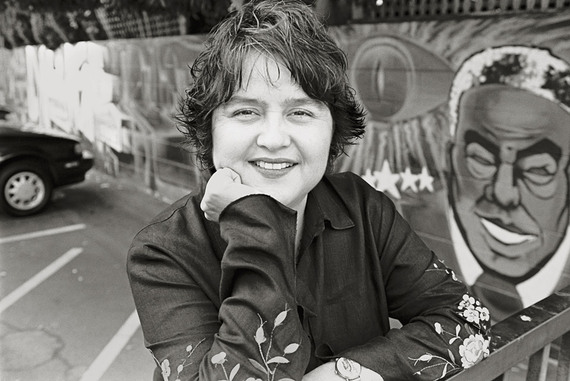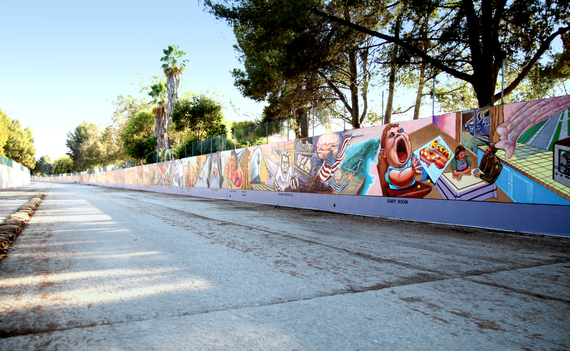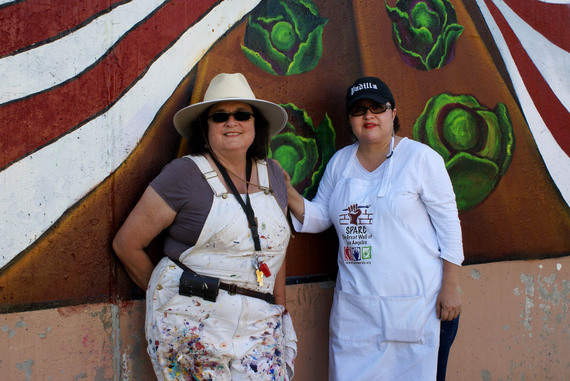Social and Public Art Resource Center (SPARC), in the historic Venice police station, houses the UCLA@SPARC Digital Mural Lab, a comprehensive archive, a UCLA graduate program, a printmaking studio and a gallery. SPARC's most storied accomplishment is the Great Wall of Los Angeles, a half-mile long mural located in the San Fernando Valley, telling the history of Los Angeles through the eyes of people left out of history books. The mural runs along the LA River's concrete channel at the Tujunga Wash. Beginning in 1976 artist Judy Baca hired and trained teams of young people, many of them gang members and part of the juvenile justice system, to execute this story during a period in our history when there were no Latino members of the City Council or the School Board. Baca and Debra J.T. Padilla, SPARC's Executive Director since 1993, work non-stop. Debra sat down with us at SPARC to share her story.
Can you tell us how you chose your name?
One of our founders, Christina Schlesinger, says, "One day we were sitting at a big table in the dungeon buzzing with ideas for the new name. I thought back to the radical '60's group, the Weatherman, and their slogan, "It only takes a spark to start a prairie fire." Starting with SPARK we worked our way to SPARC, the Social and Public Art Resource Center. And SPARC was born."
Deborah Padilla, Social and Public Art Resource Center Executive Director
Associate Director Felipe Sanchez says that Judy sees the Great Wall mural along the Los Angeles River as, "a tattoo on the scar where the river once ran." What is the continuing role of the Great Wall of Los Angeles mural for SPARC?
Judy's dream is for us to go back to where we started. The mural has never been finished. It represents the span of history only until the 1950's. She would proclaim, "There's this unfinished thing out there..." The Great Wall is our signature work. We've raised $2.3 million for restoring the mural, which had not been done in over 30 years, and for the Great Wall Interpretive Green Bridge, made out of rammed earth and recycled debris from the river, along with signage and lighting. The Great Wall institutionally has been good for SPARC. It is our duty to steward it, to make sure future generations learn from it and contribute to its evolving history. Last year the NEA provided funding to design the images for the decade of the 1960's. Now we have to raise the funds to paint it, and do the same for the 1970's, 80's and 90's. When the mural is completed all the way into the 1990's, it will be a mile long. We imagine a day when, with viable funding, there will be amenities like picnic tables, restrooms, educational kiosks and benches at the site. 
A section of the Great Wall mural, in the Tujunga Wash of the Los Angeles River
What do you mean at SPARC when you talk about public memory?
One of the adages we believe is that history doesn't begin when you walk in the door. You are always walking into historical precedence. SPARC metaphorically excavates the land and its memory. Also, being rooted in tradition doesn't mean you cannot be contemporary in the way you see and have compassion for what is your city, your neighborhood and your community.
What is an example of art building community?
The beauty of art, to me, is about being at places like Watts Towers, one of the quintessential cultural landmarks of LA. Cultural destinations are community rooted. Going to see something like the Watts Towers is an opportunity to experience its beauty. I love it when people go somewhere new and have that 'ah- ha' moment, seeing something they had only read about.
Why are arts important?
Art has the power to illuminate, interrogate, celebrate and invigorate a moment in time worth remembering, or simply to give a kid who needs one an outlet louder and bigger than his self-doubt.
Why is it important for young people to engage in your projects?
Recently I met with a gang counselor. He wanted to take the kids he was counseling outside their comfort zone, so he took them on a scavenger hunt to the Great Wall site. He asked who was whispering into Einstein's ear, and other questions that made them look closely at the mural. He brought them here to SPARC and showed them our site, and they dialogued with Judy. They learned about the 400 kids who worked on the Great Wall of LA. The first eighty during the first summer were kids who had been part of the juvenile justice system. They didn't have a lot of academic skills, they didn't know how to paint or do math, but they were given a chance to contribute to the history of California through an ethnic prism that had been left out of history books. The arts tap into that imagination that everyone has. Everybody is a dreamer.
How did you develop a sense of belonging to your LA community?
Staying grounded is rooted in my New Mexican DNA. I arrived in LA on October 18, 1993, in my red 1964 Ford Galaxy I had purchased for $1000 on the streets of Tucson. I wrapped up about seven years as managing director of Borderlands Theater in Tucson, and drove that car across the desert to the City of Angels, where I heard the river was made of concrete. I was ready to do my best providing organizational leadership to complement the vision of SPARC's co-founder and artistic director, Judy Baca.
I was 30 years old then; today I'm 51. A lot has transpired over my 20-plus years at SPARC. I am grateful for the highs - they taught me our work matters and can have a lasting impact - and the lows, for they taught me where we could be stronger and how I could do better. I have always lived here in Venice, half a block away from SPARC. I don't have to commute, so I am involved in the context of community - how you make it and contribute to it. I believe I live a purpose-driven life. But I wish I'd kept that car for sentimental reasons. 
Judy Baca and Debra Padilla at the Great Wall mural
Being a member of the arts community is critical to my sense of purpose. I spent fourteen years on the board of Cornerstone Theater and have always been deeply vested in arts advocacy. Recently I was appointed the Chair of Arts for LA, which serves as the North Star for all things arts advocacy in LA County and City.
How does SPARC involve community members?
Community members are why we do what we do. Our Great Walls Unlimited: Neighborhood Pride Mural Program painted 105 murals in ethnic neighborhoods in Los Angeles. We hired 95 artists, both emerging and established, and hired 1100-1200 young people as apprentices. We work with schools, churches and local organizations. We want to identify the neighborhoods that could benefit most from having a deeply engaging and lasting public artwork for generations to come. We want to leave something meaningful, the fine quality of art our communities deserve. Often communities call us, asking for a SPARC piece. Our process is authentic and relevant to that community. We impact SPARC, artists, community and the youth.
What was the legacy of the Great Walls Unlimited Neighborhood Pride Mural Program?
Neighborhood Pride was one of the first most celebrated mural programs in the country at the time. Then-Mayor Tom Bradley asked Judy, "Is there any way you can replicate what you did out there at the Great Wall, and take that all over the city?" Judy designed the program, which was essential to LA's identity as the mural capital of the world, a title we no longer hold, but hope one day to re-claim. Our artists had to be empathic listeners. They were not there to tell the community what they should have, but rather the community could share with the artist their most salient issues. A defining question during the course of the program was "What would you choose to memorialize?"
The program ran from 1988 to 2003. Then the city endured a mural moratorium, when there could be no murals on private property. There's a correlation between the demise of murals with the loss of funding, the moratorium and the defacement of historic murals. SPARC played a critical role in developing the new mural ordinance that was passed last October. We have a proposal to re-institute a program and develop a mural strategy for the city with preservation, new production and education at the core. SPARC's historic partnership over 38 years with the city is very strong. Our track record is unparalleled.
What is the heart of SPARC for you?
SPARC's public arts initiatives since 1976 reflect the concerns of populations that have been disenfranchised, including women, the working poor, youth, the elderly and immigrant communities. Throughout Los Angeles and increasingly in national and international venues, SPARC's projects have often been created in impoverished neighborhoods that have been energized by the attention these murals have brought. Underlying all of SPARC's activities is the profound conviction that the voices of disenfranchised communities need to be heard and that the preservation of a vital commons is critical to a healthy society.
I'm proud of SPARC's legacy of artwork that provides an ethnic face for our city. SPARC's public projects in Los Angeles alone number in the hundreds, and are considered among the most important landmarks of our city. SPARC seeks to create understanding between the diverse ethnic groups that make up a nation of immigrants, and build respect for their contributions.
SPARC is known for involving youth. Can you tell us about a particular young person?
Ernestine's story shows the value of our work. As a young girl, fourteen years old and pregnant, Ernestine desperately needed an outlet from her troubling environment. Judy Baca immediately knew that Ernestine could benefit from the experience of working with other young people and becoming part of a monumental cultural landmark. Ernestine spent four years on the project, and became a crew leader. She has shared the story many times of how Judy Baca and the Great Wall project helped change her life many years ago.
Ernestine's story epitomizes so many similar stories over the years of how SPARC's work has truly made a difference. In her own words:
The way I grew up was, you fight through life, you know, I got ten brothers and six sisters, and I'm the baby, and there was a fight in my house all the time. And that's the way I believed you were suppose to have grown up, to fight through life. Don't like nobody but your own race, and even sometimes don't even like your own race.
There was a lot of tension, um; I think everyone wanted to fight every body; just the way they looked, or looked at them, or the way they dressed. After time you just started getting to know that person as an individual instead of knowing them as you were taught to, you know. And, everybody became very good friends. It took a lot a lot of growing up. I'm not saying that first year did it, cuz it didn't. It took a lot of growing up. But I made a lot of friends through the four years and every year I understood something else, every year.
I wouldn't have went back to high school because I wouldn't have had a role model to push me to go there. Education was Judy's number one thing. As long as I stood in school, "You can come back and paint the mural". Even though I got in trouble in school and fought and everything that was my number one goal. I wanted to come back. I had to come back.
What really kind of freaked me out though, was when I met the people that when we painted the mural of the Holocaust, and I met the people that had the tattoos on them, that kind of blew my mind. That actually made me cry because I knew there was another world that was harder than mine. And, I just really felt for it.
This mural opened my eyes so much. Even when I'm down and out, I still walk by here. And I thank god I did accomplish something in life. It makes me feel good. I think if it wasn't for this mural, for me to have my name on it and to have accomplished something, I don't know where I'd be.
What's a major challenge for your organization?
Garnering adequate working and human capital, along with convincing folk that our work is worth supporting. While our work strives to be about equity and inclusion, the investments in it are not. One must be a problem solver, a doer, a partner, a strategist, a planner, a roll-up-your-sleeves kind of leader, but first and foremost you must be an empathic listener and an authentic advocate for the mission of the organization. I've learned quite a bit by listening to artists, staff, board, interns, dreamers, community, taggers, politicians, funders, gang members, students, friends, family and colleagues.
Because I'm an identical twin, I see the world through "us" and "ours" very clearly. My leadership role is possible only by virtue of our great SPARC team, each of us promoting our core values since 1976 of art, community, education and social justice. SPARC can illumine a community's story, and then a sense of place and true belonging forms. We are committed to ensuring places like SPARC can thrive, not just survive. Meeting challenges while getting off our knees and on our feet towards true sustainability is my own personal mantra and wish for SPARC. Our communities, our youth and the artists we serve deserve it.
To visit the Great Wall or learn more about SPARC, visit here.